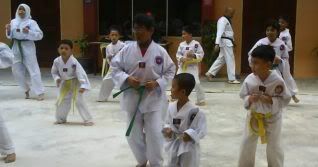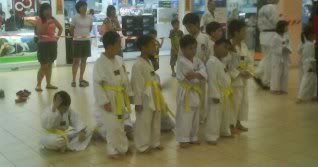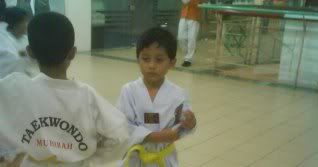They are called gup (or kup) ranks. The nine black belt levels are called degree or dan ranks.
Each color of belt, namely white, yellow, green, blue, red, black, have a particular meaning. For example, white signifies innocence; it signifies the student who is just starting with no previous knowledge of taekwondo.
The International Taekwondo Federation (ITF) uses a system of 10 kup ranks and nine dan ranks. The colour belt ranks run from 10th kup to 1st kup.
The black belt ranks run from 1st dan to 9th dan.
The 1st to 3rd dan have the title of Assistant Instructor (Boo-Sabum).
The 4th to 6th are have the title Instructor (Sabum).
7th and 8th are Master (Sahyun).
And the 9th degree as the Grand Master (Saseong).
The first Grand Master was General Choi Hong Hi, the founder of Taekwon-Do. The second Grand Master was Rhee Ki Ha, who was promoted to 9th dan by General Choi at the 1997 World Championships in Russia.
At present, there are probably about 20 Grand Masters.
According to General Choi, the reason for nine black belt degrees, is that the number three is a powerful number in the orient. For that reason, three threes must be the most powerful.
It can be noted that the World Taekwondo Federation (WTF) has 10 dan grades instead of nine.
The traditional belt colors recognized by the Kukkiwon (headquarters of the World Taekwondo Federation) are white, yellow, green, blue, and red.
Between solid colors, a central stripe down the middle of the belt reflecting the next full belt color is added to indicate progress in Gup level. For instance, from white the next belt would be white with a yellow stripe.
Some schools instead place a "tip" or belt-end stripe of the next color on a student's belt to signify a rise in rank.
Other schools opt for two-tone belts, reflecting both the lower rank and the next rank. For example, between the white belt and the yellow belt would be a belt half white, half yellow.
Some schools opt to use a solid color alternative instead of stripes. A common belt-color scheme is: white, yellow, gold, orange, green, purple, blue, brown, red.
There is no standardization in belt colors in the United States or elsewhere.
In Australia, many schools use white, yellow, blue, red and black. In these schools progression through gup levels is signified by white stripes near the tip if the belt, so white or yellow I, yellow II & III, blue I, II & III, red I, II & III, then red belt with black tip for Cho Dan Bo (sort of black belt in-training) and black for Cho Dan (1st Dan).
Another system in use in Australia is White, Yellow, Green, Blue, Brown, Black, with intermediate kups/gups being indicated by a stripe of the higher color. This is usually 1/4 to 1/2 inches wide and is going across the belt, close to one of the end.
This is usually called a 'tip'. For example, 3rd kup is blue belt, brown tip.
Rank advancement records are kept by the school of origin and often by the style's association headquarters.
Black Belt ranks are recognized as:
1st - 3rd, Instructor.
4th - 6th, Master.
7th - 9th, Grand Master.
In the past, tenth dan has been reserved as a posthumous award. But in recent years it has seen presentation to a few living, Korean recipients.
















